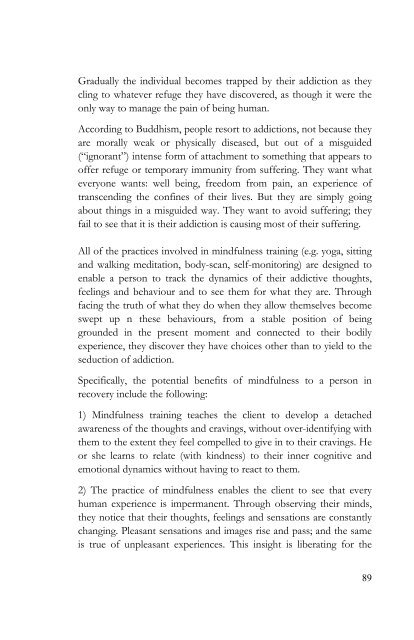Introduction to Mindfulness - Dean Amory
Art and Benefits of Mindfulness Meditation
Art and Benefits of Mindfulness Meditation
You also want an ePaper? Increase the reach of your titles
YUMPU automatically turns print PDFs into web optimized ePapers that Google loves.
Gradually the individual becomes trapped by their addiction as they<br />
cling <strong>to</strong> whatever refuge they have discovered, as though it were the<br />
only way <strong>to</strong> manage the pain of being human.<br />
According <strong>to</strong> Buddhism, people resort <strong>to</strong> addictions, not because they<br />
are morally weak or physically diseased, but out of a misguided<br />
(“ignorant”) intense form of attachment <strong>to</strong> something that appears <strong>to</strong><br />
offer refuge or temporary immunity from suffering. They want what<br />
everyone wants: well being, freedom from pain, an experience of<br />
transcending the confines of their lives. But they are simply going<br />
about things in a misguided way. They want <strong>to</strong> avoid suffering; they<br />
fail <strong>to</strong> see that it is their addiction is causing most of their suffering.<br />
All of the practices involved in mindfulness training (e.g. yoga, sitting<br />
and walking meditation, body-scan, self-moni<strong>to</strong>ring) are designed <strong>to</strong><br />
enable a person <strong>to</strong> track the dynamics of their addictive thoughts,<br />
feelings and behaviour and <strong>to</strong> see them for what they are. Through<br />
facing the truth of what they do when they allow themselves become<br />
swept up n these behaviours, from a stable position of being<br />
grounded in the present moment and connected <strong>to</strong> their bodily<br />
experience, they discover they have choices other than <strong>to</strong> yield <strong>to</strong> the<br />
seduction of addiction.<br />
Specifically, the potential benefits of mindfulness <strong>to</strong> a person in<br />
recovery include the following:<br />
1) <strong>Mindfulness</strong> training teaches the client <strong>to</strong> develop a detached<br />
awareness of the thoughts and cravings, without over-identifying with<br />
them <strong>to</strong> the extent they feel compelled <strong>to</strong> give in <strong>to</strong> their cravings. He<br />
or she learns <strong>to</strong> relate (with kindness) <strong>to</strong> their inner cognitive and<br />
emotional dynamics without having <strong>to</strong> react <strong>to</strong> them.<br />
2) The practice of mindfulness enables the client <strong>to</strong> see that every<br />
human experience is impermanent. Through observing their minds,<br />
they notice that their thoughts, feelings and sensations are constantly<br />
changing. Pleasant sensations and images rise and pass; and the same<br />
is true of unpleasant experiences. This insight is liberating for the<br />
89

















